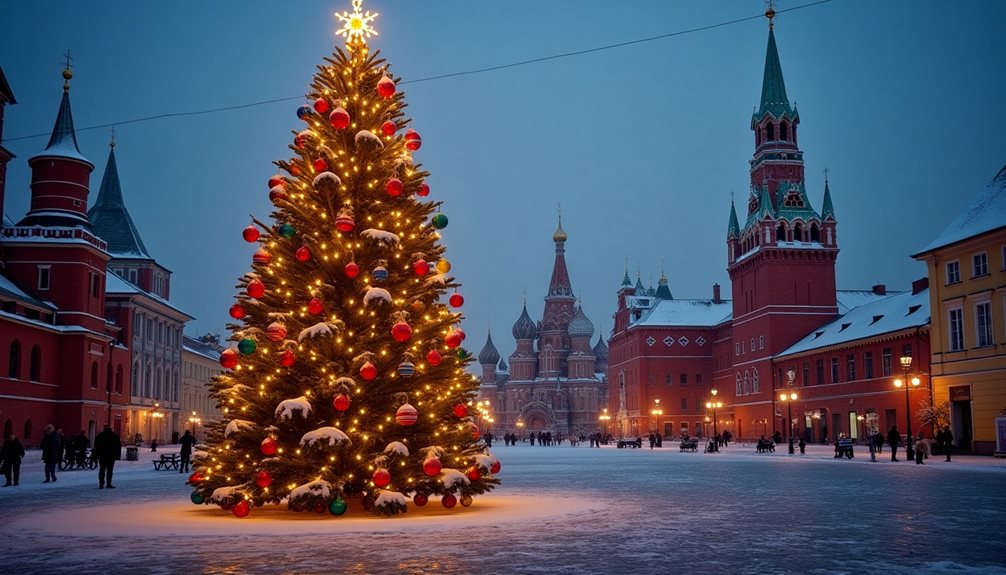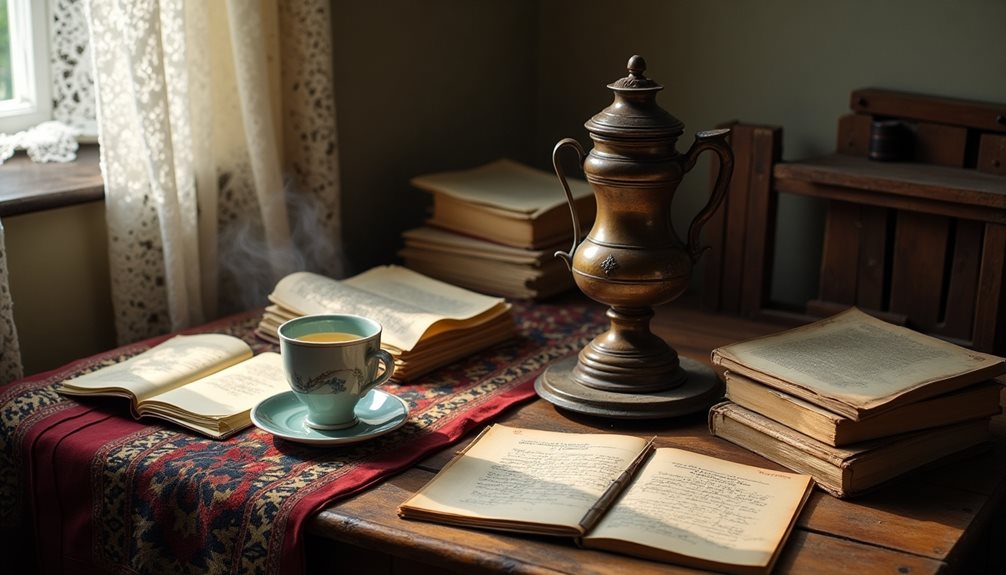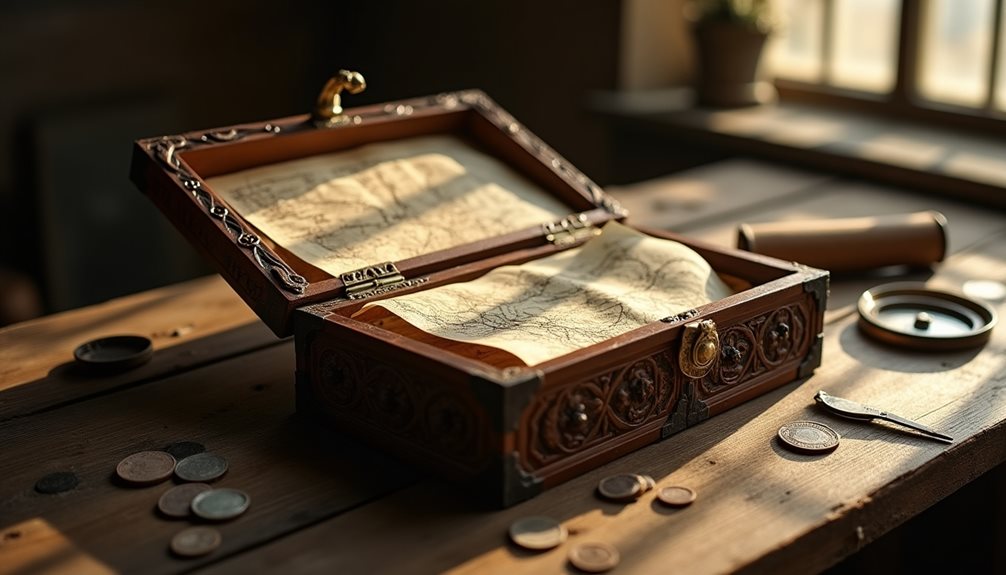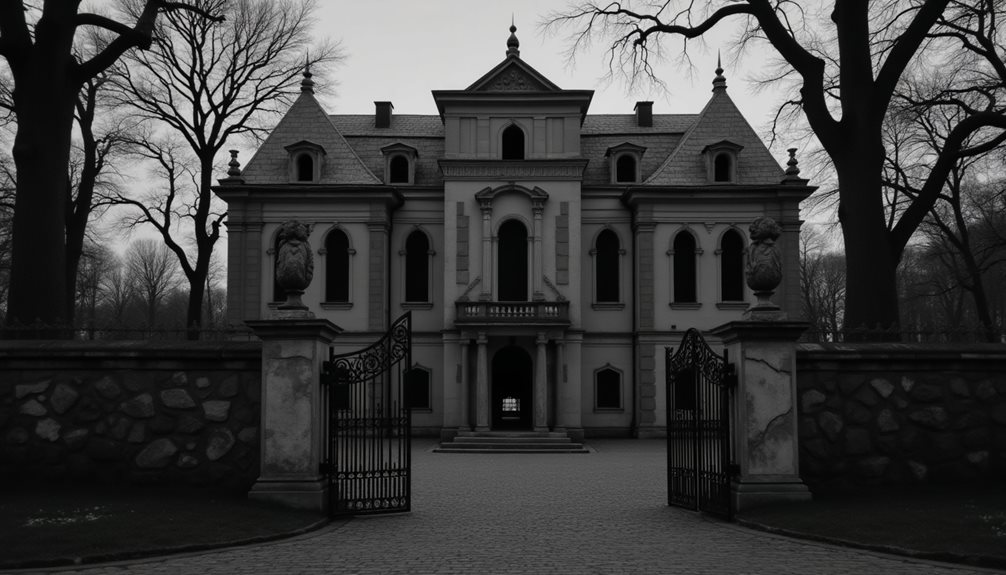Russia’s National Unity Day, observed on November 4th, stands as a symbol of resilience and cultural pride, marking the pivotal moment in 1612 when Russian forces expelled foreign invaders from Moscow. Since its reestablishment in 2005, this day has taken on a new significance, transcending its historical roots to foster a sense of national cohesion and identity amidst modern challenges. The celebrations, filled with parades and cultural events, highlight the diverse tapestry of Russian society. Yet, beneath the festive surface lies a complex narrative of historical reinterpretation and contemporary relevance that invites further exploration.
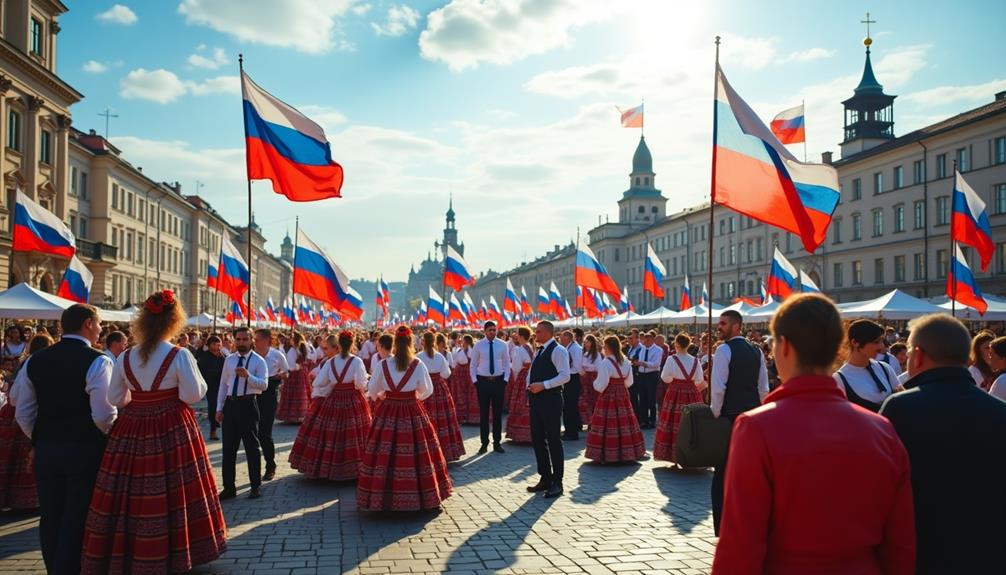
National Unity Day in Russia, observed annually on November 4th, commemorates the expulsion of Polish-Lithuanian forces from Moscow in 1612, a pivotal event during the Time of Troubles.
Instituted in 2005 to replace the Soviet-era November 7th holiday, this day aims to foster national cohesion and reflect on Russia’s historical resilience.
The choice of date underscores a narrative of overcoming foreign intervention, and its significance is rooted in its portrayal of unity and patriotism in the face of adversity.
National Day of Unity
Celebrated annually on November 4th, National Unity Day in Russia owes its origins to a pivotal moment in the early 17th century, known as the Time of Troubles. This period profoundly shaped Russia’s cultural identity and historical memory.
The day symbolizes national pride, reflecting the collective resilience that overcame foreign intervention and internal chaos. Modern implications of this event are evident in how it fosters civic engagement, reminding citizens of their shared past and encouraging a unified national front.
Commemorating National Unity Day underscores the importance of historical memory in shaping a cohesive society. It serves as a reminder that unity in diversity can lead to profound national strength, reinforcing ideals that resonate with those valuing freedom and community solidarity.
The Time of Troubles
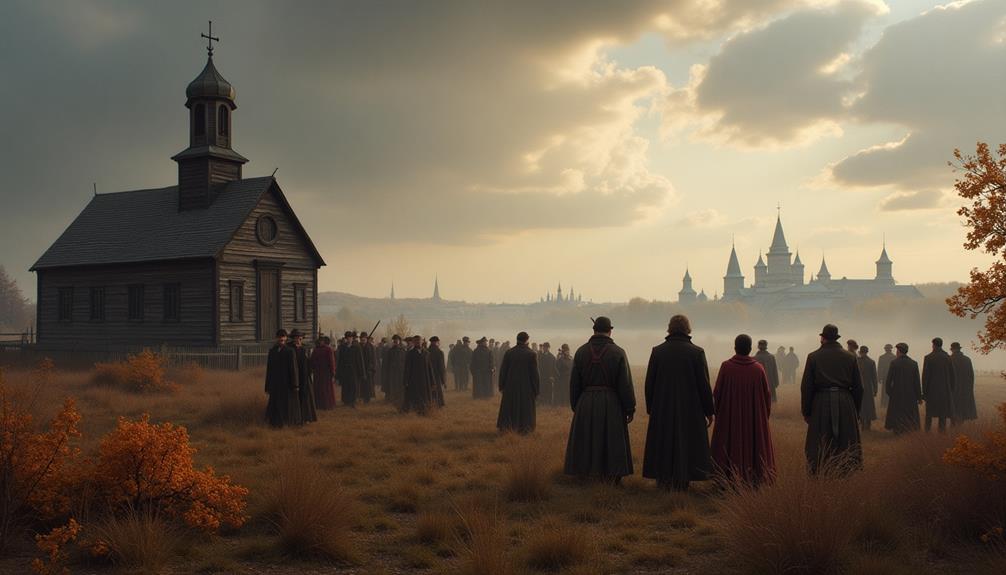
Amidst the turbulence of late 16th and early 17th century Russia, the Time of Troubles emerged as a period marked by political chaos, social upheaval, and foreign intervention.
This era, following the death of Tsar Ivan IV, was characterized by a power vacuum and the subsequent succession crisis. Political turmoil ensued as various factions vied for control, leading to widespread societal impact.
The Polish-Lithuanian Commonwealth’s invasion exemplified foreign intervention, further destabilizing the region.
However, amidst these challenges, Russia demonstrated cultural resilience, as communities rallied to preserve their identity.
This period’s historical context underscores the complexities of governance and sovereignty, illustrating how struggles for freedom and self-determination can shape a nation’s trajectory.
Such resilience eventually paved the way for the eventual restoration of order.
As the Time of Troubles unfolded, Russia was beset by a confluence of social and political crises that tested the very foundations of its society.
Political dissent grew amid widespread economic instability, exacerbating tensions within a populace already weary from government corruption. The disintegration of central authority led to pervasive social unrest, as different factions vied for power in a leaderless state.
Public protests became a common expression of discontent, reflecting the populace’s desire for reform and accountability. Evidence from this period highlights how the lack of effective governance eroded public trust, fostering an environment ripe for upheaval.
These challenges underscored the urgent need for systemic change, as citizens yearned for a more equitable and transparent political landscape.
During the Time of Troubles, the Polish-Lithuanian Commonwealth’s invasion and subsequent occupation of Moscow represented a pivotal moment that further destabilized an already fragile Russia.
The Polish Lithuanian invasion was propelled by strategic military maneuvers, including leveraging internal Russian dissent. The Moscow occupation in 1610 marked a significant power shift, as Polish forces sought to install a puppet ruler, thereby deepening the political crisis.
The historical impact was profound, igniting a nationalistic fervor that eventually led to resistance movements within Russia. Militarily, the Commonwealth’s strategies underscored the vulnerabilities of Russian defenses.
Culturally, the occupation imposed foreign influences that intensified Russian desires for sovereignty. This period underscored the importance of national unity in the face of external aggression and internal disarray.
The Uprising and Liberation
Kuzma Minin and Dmitry Pozharsky emerged as key figures during Russia’s Time of Troubles in the early 17th century, leading a national uprising against Polish occupation
Minin, a merchant from Nizhny Novgorod, rallied financial and popular support, while Prince Pozharsky provided military leadership.
Pozharsky, born in 1578, was an experienced military commander who had previously served under Tsar Vasily Shuisky
In 1611, while recovering from wounds, he was invited to lead a new militia organized by Minin in Nizhny Novgorod
In March 1612, Pozharsky led the army from Nizhny Novgorod to Yaroslavl, where he established a provisional government
The forces then moved to Moscow, engaging in battles with Polish troops
On November 4, 1612, Pozharsky’s forces liberated Moscow, marking a decisive victory
Following the liberation, Pozharsky and Trubetskoy headed a provisional government that convened the Assembly of the Land, which elected Michael Romanov as tsar in January 1613
Pozharsky was made a boyar and continued to serve in various military and administrative roles during Michael’s reign
The actions of Minin and Pozharsky are celebrated as symbols of national unity and resistance
Their legacy is commemorated through monuments and is central to Russia’s National Unity Day.
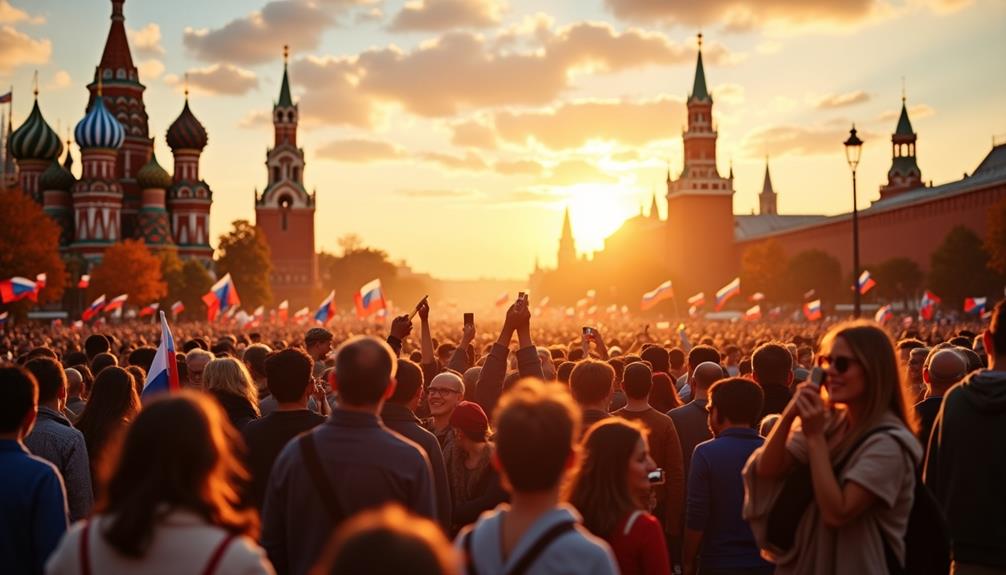
Formal recognition of National Unity Day as a public holiday in Russia marked a significant change from a historical acknowledgment to a culturally embedded tradition. Instituted by Tsar Mikhail Romanov, the alteration underscored its cultural significance by intertwining the commemoration with the burgeoning national identity.
Celebrated until 1917, this period affirmed the holiday’s role in shaping historical narratives, fostering unity among diverse Russian communities. Public perception of the event evolved, reflecting its modern implications for societal cohesion.
The celebration of National Unity Day before 1917 served as a symbolic reminder of resilience against foreign domination, reinforcing collective memory and identity.
Modern Revival
The resurgence of National Unity Day in modern Russia represents a deliberate effort to reclaim and redefine historical narratives and national identity in the post-Soviet era.
This revival seeks to bolster cultural identity by reinvigorating national symbols that resonate with a collective memory beyond Soviet ideologies. By emphasizing unity, the holiday fosters civic engagement and societal cohesion, prompting citizens to reflect on their shared heritage.
Evidence suggests that such initiatives aim to strengthen national solidarity, creating a sense of belonging amidst the complexities of a globalized world.
Reintroduction of Unity Day
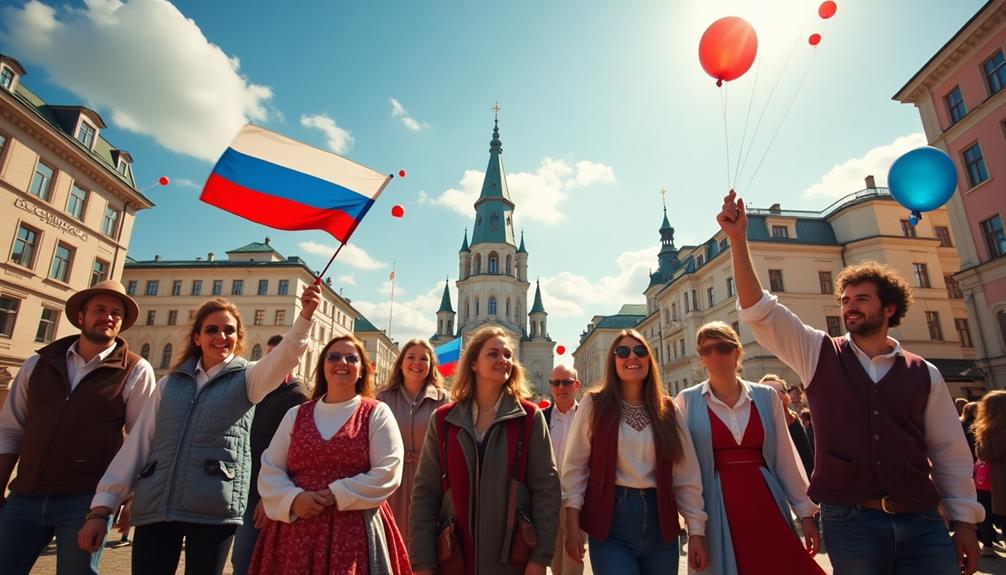
Reinstating Unity Day in 2005 served as a strategic move by President Vladimir Putin to foster national cohesion and promote a sense of historical continuity in post-Soviet Russia.
This holiday emphasizes cultural identity by reviving the historical memory of the 1612 expulsion of Polish-Lithuanian forces, highlighting national pride and resilience.
It is laden with political symbolism, as it seeks to unify the collective consciousness around a shared past, moving away from divisive Soviet narratives.
By celebrating this event, Putin aimed to consolidate power through the creation of a cohesive national story, appealing to a society yearning for stability and unity.
In the aftermath of the Soviet Union’s dissolution, Russian society experienced significant shifts in values, necessitating a reexamination of its cultural and historical identity.
This change challenged societal cohesion, as divergent historical narratives and cultural identities emerged. The reintroduction of National Unity Day in 2005 sought to address these fractures by fostering a collective memory rooted in national pride.
By commemorating the 1612 expulsion of Polish forces from Moscow, the holiday serves as a symbolic anchor, reinforcing a shared historical narrative.
In a landscape where past allegiances were redefined, Unity Day aims to galvanize a sense of belonging and togetherness.
It symbolizes an effort to bridge the gaps of a fragmented post-Soviet society, endeavoring to instill a cohesive national identity.
Celebrations and Traditions
Although rooted in historical significance, National Unity Day in Russia has evolved into a vibrant celebration characterized by diverse traditions and public festivities.
The day serves as a canvas for cultural expressions, where regional variations highlight Russia’s vast ethnic and cultural diversity. Historical symbolism is woven into the celebrations, reminding participants of the 1612 liberation from Polish occupation.
Community gatherings are central to the festivities, fostering a sense of togetherness and shared identity among citizens. These gatherings often feature festive cuisine, showcasing traditional Russian dishes that reflect regional tastes and heritage.
The dynamic nature of these celebrations underscores the importance of unity in a nation with a complex history, emphasizing freedom and the collective spirit of its people.
How Unity Day is Celebrated Today
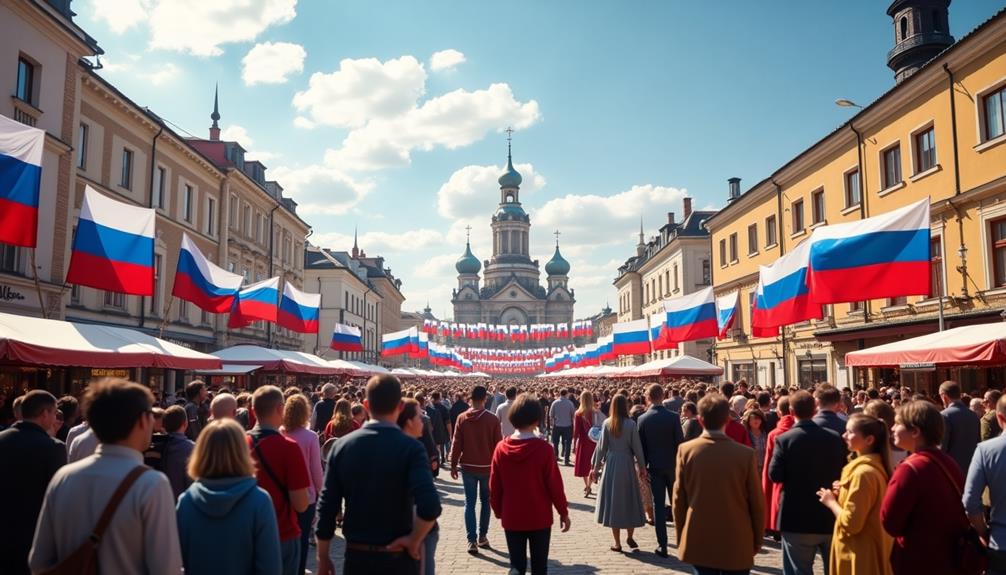
Often overlooked in discussions about Russia’s National Unity Day is the concurrent celebration of the Feast of Our Lady of Kazan, which adds a significant layer of cultural and historical depth to the modern observance.
This feast holds profound significance as it intertwines national identity with religious observance, highlighting cultural traditions that stretch back centuries. The icon of Our Lady of Kazan is not just a religious symbol but a marker of national resilience, reflecting historical parallels with periods of struggle and triumph.
Celebrated since the time of the Tsars, this feast day reinforces the unity theme by connecting past and present through shared values and beliefs. Its confluence with Unity Day underscores a collective memory, promoting a vision of freedom intertwined with faith and tradition.
Public participation in Russia’s National Unity Day is characterized by diverse community engagement, with celebrations varying considerably across different regions.
In major cities like Moscow and Nizhny Novgorod, activities range from large-scale parades and cultural exhibitions to concerts and public forums, each reflecting local traditions and historical narratives.
Community engagement is fostered through local festivals, where regional traditions are showcased, promoting cultural exchange among diverse groups. These events often include traditional music, dance, and crafts, allowing participants to immerse themselves in the unique cultural fabric of each area.
The festivities held in major Russian cities such as Moscow and Nizhny Novgorod during National Unity Day exemplify the intricate blend of tradition and modernity, reflecting the cities’ pivotal roles in shaping Russia’s cultural and historical landscape.
Moscow parades are vibrant spectacles, showcasing cultural performances that illustrate the nation’s diverse heritage, while simultaneously fostering a sense of unity among participants.
In Nizhny Novgorod, festivals engage communities through traditional foods and crafts, offering both locals and visitors a tangible connection to Russian customs.
Community gatherings in these cities serve as platforms for dialogue and celebration, emphasizing a shared national identity.


